What I Learned By Recording My Classes
A MiddleWeb Blog
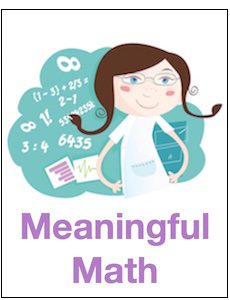 New technology is making it easier than ever to create informal classroom recordings of teachers teaching and students learning. Why do it? For me, the opportunities to improve my practice are worth the extra effort.
New technology is making it easier than ever to create informal classroom recordings of teachers teaching and students learning. Why do it? For me, the opportunities to improve my practice are worth the extra effort.
I have recently purchased a SWIVL thanks to a grant a co-worker and I wrote, and I’m using my iPad to record my classes. If you haven’t used a SWIVL before, you simply put your iPad into the SWIVL base, wear a SWIVL marker device around your neck, and the iPad will follow you and record the visual and the audio.
If buying a SWIVL isn’t feasible (I paid about $600 for mine), there are a multitude of ways to record your classroom. In fact, the only reason I have a SWIVL is because I had borrowed one from the library at school and liked the versatility enough to try for a grant.
In the past, I just set up my iPad without the SWIVL and captured what I could. In my mind, the advantages with the SWIVL are the ability capture different vantage points and to improve the sound quality.
Why record your lessons?
I wanted to record my lessons so I could look back, tweak my lessons, and generally experience my classroom as an observer. I also wanted to gauge student engagement and interactions. In short, I wanted to use the videos to help me reflect more deeply about what goes on when I’m teaching.
Classroom recording is not a new idea, of course. For many years I enjoyed watching the original Teaching Channel which featured short clips of teachers and students in a variety of settings. It was my experience watching those clips that encouraged me to begin recording my own lessons.
My initial goal was to record my students during at least one class per day, every day for a month. Well, that did not happen – not even close. With standardized testing, tornado and fire drills, and numerous student activities, I was only able to record during four different days. I am hoping to do better next month.
What did I find?
When I sat down to watch my first lesson, it was difficult. Reality turned out to be much different than the idea that I had in my head. However, after I got past the initial discomfort at watching myself, I could actually start noticing what was going on in my classroom.
As I watched my video, I made notes on a simple template I found online. I knew I needed to make notes that I could go back to and it also helped me organize my thoughts. The notes I took were very short and to the point. For example, one note said, “I struggled to respond to students’ questions without flat out giving the answer.” Another note said, “I asked a student a question, then I interrupted the student and answered it myself!” Other notes were more encouraging, such as, “using stations for test review went well today.”
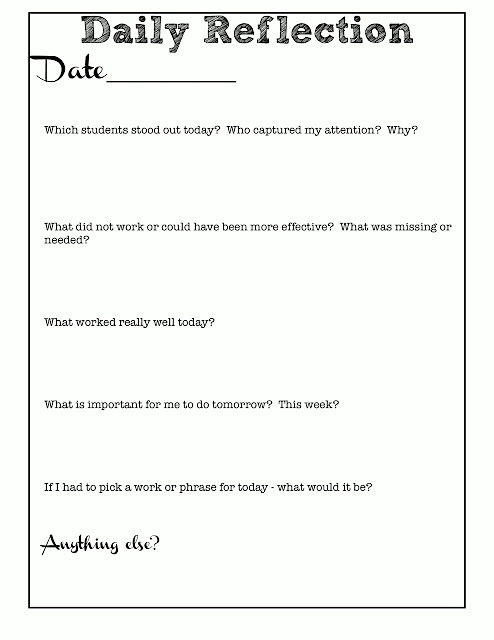
I actually enjoyed watching as the students worked with each other to solve problems and figure things out. I watched with interest to see if students were off task. In general, the classes in which students were working in groups seemed to go well.
I think in part this was because they are used to it and know what I expect. We have spent a lot of time discussing the need for them to be responsible for their learning and to work with each other to get help. I was pleasantly surprised to see that when students had the opportunity to work in groups they stayed on task for the most part.
However, as I watched the video I saw there were a few students who seemed to struggle more than I had realized. In response, I plan to create some extra supports for them. I was also surprised to see that I consistently spent a little more time with some groups than others, something I am glad to be aware of.
Another eye opener for me has been how often my facial expressions or tone conveyed impatience or frustration. I thought I maintained a neutral expression for the most part, but after watching the video I realize I need to do a better job with my demeanor.
Responding to what I’ve learned
What I had in my mind was a lot different than what I saw and the reality of how I teach. I will admit that after I watched a few lessons I was tempted to try to change everything I did. But I know that’s not reasonable, so I looked back at my notes and came up with two things to focus on.
► My use of questioning came up more than once in my notes, so I plan to work on that. I need to ask better questions which lead students to correct understanding. I noticed that I asked a lot of very basic questions. For example, when working through an equation I might ask out loud, what will I get when I divide 9 by 3? Those types of questions do not add to student understanding.
I think I began doing that when I first started teaching to see if students were paying attention, and I just do it out of habit now. So I am going to try to develop good, conceptual questions for my lessons. Fortunately, one of my colleagues is great at this and she is always willing to help me!
► The portion where I give direct instruction, usually the first few minutes of class, needs serious improvement. For me, it was the hardest part to watch. I really think part of the reason is because I have focused so much on student centered learning (and rightly so) that I have become weaker with direct instruction.
I think I need to work on my delivery a little bit. I am going to try to do a better job of introducing the material and providing the “hook” for the lesson. So, I will be also looking at that during my next round of videos.
The benefits I’ve experienced
I have found that recording my lessons has really helped me reflect in a very different way. It’s hard to argue with what you see with your own eyes, and it was good for me to see what my students see. The video has helped me focus on things other than strictly pedagogical practices, such as my posture and facial expressions.
I am a naturally shy person and sometimes I get unnerved when I have visitors in my classroom, so videoing my lessons is a way for me to share what I am doing with a little less stress.
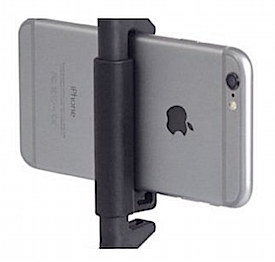
If you haven’t recorded yourself teaching, I strongly recommend it. It could easily be done with an iPad or even your phone (using an inexpensive mount), and you can do an internet search and find a variety of recording ideas.
Recording my class has motivated me to make better lessons and to ask better questions, and I plan to make it a regular part of my teaching life.

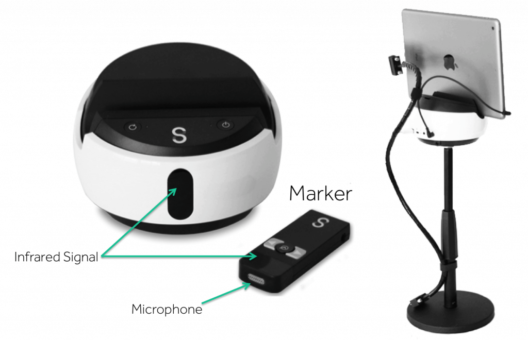
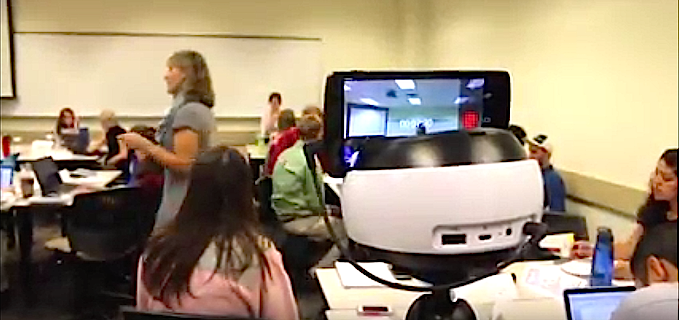




































Hi there!
This seems like such a great thing to do for personal professional improvement, but also, for students who are ill, MIA or on prolonged trips. I assume you can post lessons etc. Also, I am sure permission slips need to be signed if posting is an option.
What I would like to know is: What pieces of equipment would I need to purchase to start doing this? Do you have the specific names of each piece? I don’t know where to start with setup etc…
I would appreciate your input very much!
Thank you for the inspiring post.
All Best,
J.J.
Hi Jennie!
I am currently in a teacher ed program and we have a bunch of these devices! We use them as well to record ourselves teaching and then reflect just as Michelle does, we also use them for our edTPA taping.
The device is called a SWIVL (https://www.amazon.com/Swivl-Robotic-Platform-for-Video/dp/B00JZM7UGG). I believe that it comes with everything. The only thing that you need is your iPad or iPhone and then a free account with SWIVL.
Hope this helps!
Christopher
Christopher thank you for your comment! In addition to purchasing the unit from Amazon you can also buy directly from Swivl. I think it is so interesting that these devices are being used in teacher education programs for reflection. Reflection was not really emphasized in my teacher ed program, so I am glad to hear that new teachers are being trained to be more reflective. Thanks again!
Jennie, thank you for your comment! You are correct about permission slips, that is a form all of our students sign at the beginning of the year. So far, I have mainly recorded my lessons for self reflection but you’re right they could also be used for students who were absent. I think the comment below explained about the equipment, but even if you can’t purchase a Swivl right now you could set up your cell phone or IPad to record your class. If you do decide to go with Swivl it’s a very user friendly process. You record with your IPad and the video automatically uploads to your free Swivl account, where you can watch it, share it, etc. Good luck!
Thank you for your honest reflection on the benefits of videotaping! I am motivated to try it more regularly myself.
Thank you! It has really helped me, the biggest challenge is just making it a routine, so I do it consistently.
Thank you for sharing. Your thinking supports the reasoning behind edTPA submissions of videotaping combined with rich commentary!
I found your post via the MindShift newsletter. I have been a teacher in a variety of settings for nearly 20 years. I congratulate you on your courage, not only to take an honest look at your practice (noting the successes, too), but to share your experience with a wider audience. Your willingness to be vulnerable for the benefit of so many others inspires me. You are a mighty one! Thank you! May you enjoy many years of satisfying good work!
Check out SIBME’s new device, PerchIT! Great little device to mount on your recording device and start recording.
https://www.perch-it.com/
Hello.
I am pondering a similar idea, and I’m wondering if you had any issues with students being permitted to be recorded on camera.
Thanks,
Jamie
This is a wonderful blog article! I would like to quote part of it in a book I’m currently writing for Solution Tree Publishing. Of course, I’ll cite you and recommend that readers go to your site for more good stuff! If I use a long quote, Solution Tree may contact you for permission. Let me know if that’s ok. Thanks!
Yvonna Graham
Yvonna – We’ve written to you about this. So glad you found the article important enough to include some of its content in your upcoming book.